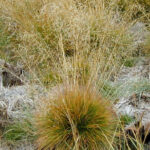Tufted Hairgrass
Deschampsia cespitosa
General Description
Tufted hairgrass is a short-lived, tufted, cool season, native perennial bunchgrass. Roots are shallow, fibrous, and dense. A mass of deep green leaves covers the crown. Densely tufted and with numerous stems, this native grass is found throughout British Columbia. Seed production is important for stand maintenance. It is valuable as a range grass and fairly resistant to close grazing.
Type
Native grass.
Origin
North America.
Longevity
Generally considered a short-lived species.
Use
Reclamation, grazing. This highly variable species can adapt to stressful environments, and is often recommended for reclamation and rehabilitation projects.
Optimal Time of Use
Highly palatable, resistant to grazing, remains green throughout the summer, and good for pasture forage. Grazing should be deferred until the stands are established
Recovery After Use
High recovery if rotational grazing system is used. Despite this species’ resistance to grazing damage, it will decline with continuous season-long grazing.
Moderate
Palatability/Nutritional Value
Very palatable early in the season with up to 20% protein content in early May.
Annual Precipitation min/max (mm)
400mm / 600mm
Drought Tolerance
Low tolerance.
Flooding Tolerance
Adapted to seasonally flooded areas.
Winter Hardiness
High winter hardiness.
Soil Texture Preference
Can be found in a wide variety of soil types from fine to coarse.
Erosion Control
Sometimes used to stabilize stream banks, canals, and shorelines. Tolerates heavy metal contamination.
Salinity Tolerance
Tufted hairgrass is generally considered to have low salinity tolerance; however, it grows in salt marshes and coastal estuaries so some tolerance to salinity is inferred.
Acidity Tolerance
High tolerance; tolerant of pH down to 3.5.
Alkalinity Tolerance
Low tolerance, up to pH 7.5.
Seeds per kg
3,600,000 seeds/kg (1,633,000 seeds/lb)
Suggested Mixtures
Native species with similar tolerances for reclamation. Where species diversity is a goal, mixtures with less than 0.3 to 0.6 kg/ha (approx.1/4 to 1/2 lb/acre) may be required as heavier rates will have high tufted hairgrass stand content.
Ease of Establishment
Tufted hairgrass may be slow to establish the first year but will establish with adequate moisture. Seed selected from high elevations may have higher dormancy and is likely to germinate better in fall seeding applications. Seeds selected from low elevations have lower dormancy and thus can be planted in the fall or spring. Specific selections are often required for extreme soil conditions.
Competitiveness
Tufted hair grass is considered moderately competitive as it can dominate if it is seeded too heavily in a mixture, and it can be a serious competitor with trees.
Management Considerations
Tufted hairgrass will decrease with continuous season long use. Spring grazing should be deferred in wet areas until soils are dry enough to prevent pugging and damage to plants.
BC Rangeland Seeding Manual, USDA Plants Database
Tufted hairgrass is adapted to moist draws and wet meadows in all zones in the region.
Tufted hairgrass is adapted to moist draws and wet meadows in all zones in the region.
